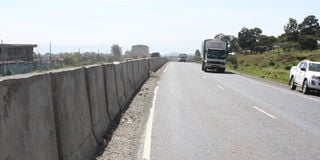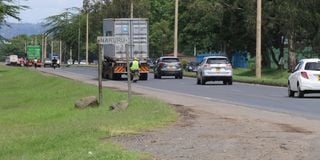Nakuru's decade-long dream: President Ruto revives hope for the Rironi-Mau summit dualing

The Nakuru-Eldoret highway at Ngata.
In a series of declarations made by President William Ruto during his State of the Nation address, it was one particular piece of information that appeared to capture the attention of Nakuru residents.
Construction of the long-awaited Rironi–Naivasha–Nakuru–Mau Summit dual carriageway will finally begin next week.
According to the Head of State, he will launch the dualling of the 170-kilometre Rironi–Naivasha–Nakuru–Mau Summit Road and break ground for the 57-kilometre Rironi–Mai Mahiu–Naivasha link on the same day.
This announcement has rekindled hopes of alleviating one of Kenya's worst traffic bottlenecks — a corridor where gridlock routinely paralyses movement during weekends and holidays.
For many Kenyans, particularly those living on the A8 route, this announcement will sound familiar as the project has been planned for years and has experienced multiple delays and changes to the timeline.

The Nakuru-Eldoret highway at Ngata.
Even this year alone, the launch date has been postponed repeatedly since July, raising questions about whether the next announcement will finally result in tangible progress.
The dream of transforming the Nairobi–Nakuru–Mau Summit highway predates the current administration and was initially proposed as one of the country's most ambitious public–private partnership (PPP) road projects. Several issues have slowed progress.
Successive governments have promised to decongest the highway, modernise key economic corridors and reduce the chronic traffic jams on the Naivasha–Nakuru stretch.
The project will cost Sh80 billion, possibly rising to Sh194 billion by completion, and will be undertaken under a 30-year concession.
Additionally, motorists will pay a base toll rate of Sh8 per kilometre, increasing by 1% each year.
Although the President’s announcement has revived optimism, scepticism remains. For residents and motorists who have waited nearly a decade, the coming week may signal the first concrete sign that the journey to 'Canaan' has truly begun.
The urgency of the project is underscored by the fact that, as of March, more than 160 lives had been lost on this infamous stretch of road, and this number continues to rise.

The Nakuru-Eldoret highway at Ngata.
According to the Kenya National Highways Authority (KeNHA), the project covers over 230 kilometres across two main corridors: The A8 (Nairobi–Nakuru–Mau Summit) and the A8 South (Nairobi–Mai Mahiu–Naivasha).
Construction is expected to begin before January 2026 and be completed within two years.
Here’s what you need to know:
• A8: Nairobi–Nakuru–Mau Summit
• Total stretch: ~175 km
• Nairobi–Naivasha (0–58.9 km): Upgraded into a dual 4-lane carriageway.
Naivasha–Nakuru West (58.9–123 km): Expanded into a dual six-lane carriageway to handle high-traffic segments.
• Nakuru–Mau Summit (123–175.7 km): Dual 4-lane carriageway.
• Nakuru town: A full viaduct will be built to maintain smooth traffic flow above the urban core.
• Six toll stations along this route.
• A8 South: Nairobi–Mai Mahiu–Naivasha
• Total length: 56.8 km
• Nairobi–Mai Mahiu: upgraded to a dual four-lane carriageway with climbing lanes for steep sections.
• Mai Mahiu–Naivasha: rehabilitated and resurfaced, but not expanded.
• Two toll stations.
According to KeNHA, safety measures will particularly target fog-prone and high-gradient zones, with improvements to drainage, lighting and signage.


